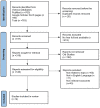The Role of the Biosafety Cabinet in Preventing Infection in the Clinical Laboratory
- PMID: 38288229
- PMCID: PMC10823295
- DOI: 10.7759/cureus.51309
The Role of the Biosafety Cabinet in Preventing Infection in the Clinical Laboratory
Abstract
Clinical laboratories are essential in healthcare to better diagnose, treat, and track medical diseases. However, handling infectious organisms and possibly infectious materials in these laboratories puts the safety of laboratory workers and the general public at risk. By controlling the distribution of infectious substances and stopping the spread of diseases, biosafety cabinets (BSCs) have become crucial tools in guaranteeing laboratory safety. The prevention of infections is most important in medical and laboratory settings. In clinical laboratories, biological and infectious agents are handled, posing threats to healthcare workers and the general public. To avoid infections, proper training of the BSC is essential. Laboratory employees are instructed in aseptic procedures, proper hand posture, and efficient personal protection when working in the cabinet. These instructions decrease the chance of contaminating the surrounding area. Additionally, user ergonomics are taken into account while designing BSC, reducing operator fatigue, and guaranteeing that staff can execute tasks precisely for extended periods. This review highlights the importance of biosafety cabinets in maintaining a secure laboratory environment and explains their crucial function in infection control.
Keywords: aerosols; biosafety cabinet; laboratory safety; microorganism; pathogen.
Copyright © 2023, Jagtap et al.
Conflict of interest statement
The authors have declared that no competing interests exist.
Figures
Similar articles
-
Selection and application of biological safety cabinets in diagnostic and research laboratories with special emphasis on COVID-19.Rev Sci Instrum. 2021 Aug 1;92(8):081401. doi: 10.1063/5.0047716. Rev Sci Instrum. 2021. PMID: 34470433 Free PMC article. Review.
-
Laboratory Safety: Handling Burkholderia pseudomallei Isolates without a Biosafety Cabinet.J Clin Microbiol. 2021 Jun 18;59(7):e0042421. doi: 10.1128/JCM.00424-21. Epub 2021 Jun 18. J Clin Microbiol. 2021. PMID: 33910967 Free PMC article.
-
Analysis of variation in total airborne bacteria concentration to assess the performance of biological safety cabinets in microbial laboratories.Saf Health Work. 2014 Mar;5(1):23-6. doi: 10.1016/j.shaw.2014.01.001. Epub 2014 Jan 24. Saf Health Work. 2014. PMID: 24932416 Free PMC article.
-
A Biological Safety Cabinet Certification Program: Experiences in Southeast Asia.Appl Biosaf. 2016 Sep;21(3):121-127. doi: 10.1177/1535676016661769. Appl Biosaf. 2016. PMID: 27721674 Free PMC article.
-
[Designing a clinical microbiology laboratory].Enferm Infecc Microbiol Clin. 2010 Aug-Sep;28(7):453-60. doi: 10.1016/j.eimc.2009.04.016. Epub 2009 Sep 9. Enferm Infecc Microbiol Clin. 2010. PMID: 19740573 Review. Spanish.
Cited by
-
Molecular mechanisms underlying the potential anticancer activity of Pulicaria crispa hexane fraction in HCT116 cancer cells.3 Biotech. 2025 Aug;15(8):257. doi: 10.1007/s13205-025-04423-1. Epub 2025 Jul 15. 3 Biotech. 2025. PMID: 40672135 Free PMC article.
-
Evaluation of protexin probiotics on the growth, and health of Cirrhinus mrigala (Mrigal).Sci Rep. 2025 Feb 20;15(1):6172. doi: 10.1038/s41598-025-89495-y. Sci Rep. 2025. PMID: 39979417 Free PMC article.
References
Publication types
LinkOut - more resources
Full Text Sources

